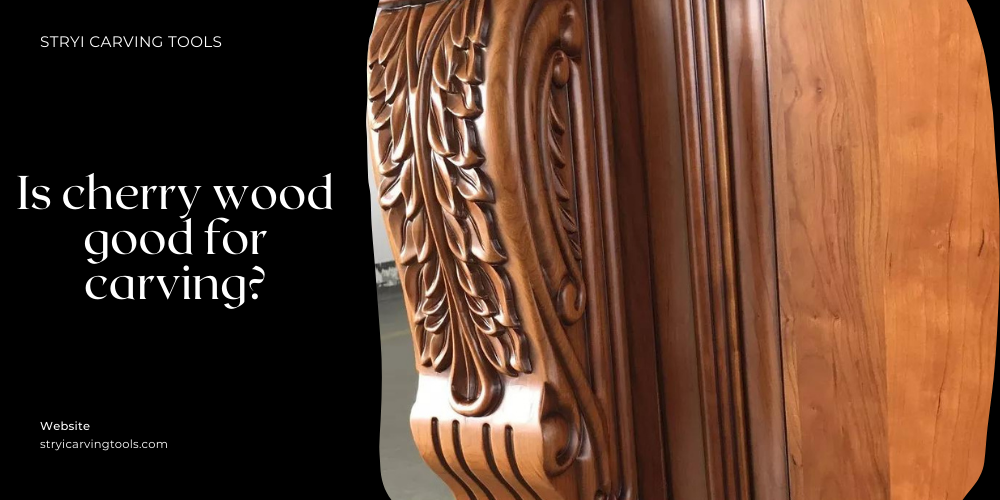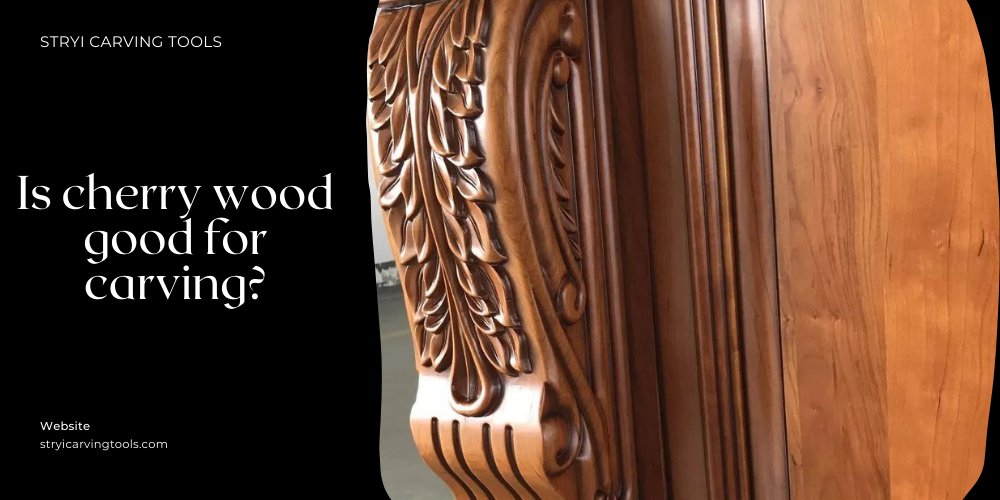If you’ve ever wondered, “Is cherry wood easy to carve?”, you’re in the right place! Carving wood can be a fantastic hobby or a skillful trade, and knowing which wood is best suited for carving is essential. In this article, we’ll explore the characteristics of cherry wood and whether it’s a beginner-friendly option for carving projects. So, get ready to uncover the secrets of cherry wood carving!
Cherry wood is renowned for its beautiful color and grain patterns, making it a popular choice among woodworkers. But what about its carving properties? Many carvers appreciate cherry wood for its medium density, which strikes a balance between being workable and durable. Carving cherry wood allows for intricate detailing while still providing strength to the finished piece. So, if you’re looking to create intricate designs without compromising structural integrity, cherry wood might be just what you need!
Not only is cherry wood a pleasure to carve, but it also offers a delightful finishing touch. Once carved, cherry wood reveals a smooth surface that readily accepts stain or polish, enhancing its natural beauty. Whether you’re a beginner or an experienced carver, cherry wood provides a satisfying carving experience and a stunning outcome. So, grab your tools, unleash your creativity, and let the cherry wood carving journey begin!

Is Cherry Wood Easy to Carve? The Ultimate Guide
Cherry wood is known for its beauty and versatility in woodworking projects. But one question that often arises is whether cherry wood is easy to carve. In this comprehensive guide, we will delve into the characteristics of cherry wood, its suitability for carving, and provide valuable tips and insights for those looking to work with this exquisite wood. So, if you’re curious about whether cherry wood is a good choice for your carving projects, read on to find out everything you need to know.
The Characteristics of Cherry Wood
Before we can determine whether cherry wood is easy to carve, it’s important to understand its characteristics. Cherry wood is known for its rich, reddish-brown color and smooth grain. It has a moderate density, making it relatively easy to work with using both hand tools and power tools. Cherry wood also has a subtle fragrance and is prized for its natural beauty and ability to develop an attractive patina over time. These features make cherry wood a popular choice among woodworkers for a variety of projects.
The Ease of Carving Cherry Wood
When it comes to carving, cherry wood is generally considered to be moderately easy to work with. Its relatively low density compared to other hardwoods makes it easier to carve intricate details and achieve smooth finishes. The fine grain of cherry wood allows for precise carving and intricate designs. However, it’s worth noting that cherry wood can be slightly harder and more prone to splintering than some other carving woods like basswood or pine. Therefore, it’s important to use sharp tools and employ proper carving techniques to achieve the best results.
Additionally, the condition of the cherry wood can also affect the ease of carving. Freshly cut or green cherry wood is generally softer and easier to carve than seasoned or dried cherry wood. Green cherry wood is more forgiving and less likely to split or crack during the carving process. If you’re able to work with green cherry wood, it can make the carving process even easier.
Overall, while cherry wood may require some extra care and attention while carving, it offers a satisfying carving experience and beautiful end results.
Tips for Carving Cherry Wood
If you’re considering carving cherry wood, here are some useful tips to help you achieve the best results:
- Use sharp tools: Keeping your carving tools sharp will ensure clean cuts and minimize the risk of splintering.
- Start with a design: Before you begin carving, have a clear design in mind or on paper. This will help guide your carving process and ensure accuracy.
- Work in the direction of the grain: Carving against the grain can lead to tear-out and rough surfaces. Always carve in the direction of the wood’s grain for smoother results.
- Make light, shallow cuts: Taking your time and making small, controlled cuts will help prevent mistakes and allow for fine details.
- Sand for a smooth finish: Once you’ve completed your carving, sand the surface of the cherry wood to achieve a smooth finish. Start with a coarse grit and gradually move to finer grits for the best results.
By following these tips and practicing patience and precision, you’ll be able to carve cherry wood with ease and create stunning works of art.
Caring for Carved Cherry Wood
Once you’ve completed your carving project, it’s important to properly care for and maintain the cherry wood to ensure its longevity and beauty. Here are some essential tips for caring for carved cherry wood:
- Avoid direct sunlight: Keep your carved cherry wood away from direct sunlight, as prolonged exposure can cause the wood to fade and lose its luster.
- Regularly dust and clean: Use a soft, dry cloth to regularly dust the carved cherry wood. For deeper cleaning, lightly dampen the cloth with water and wipe the surface gently. Avoid using harsh chemicals or abrasive cleaners that can damage the wood.
- Apply a protective finish: To protect the carved cherry wood from moisture and other potential damage, consider applying a finish such as wax or polyurethane. Follow the manufacturer’s instructions for proper application.
- Store in a controlled environment: When not in use, store your carved cherry wood in a cool, dry place with stable humidity levels to prevent warping or cracking.
By following these care instructions, your carved cherry wood will remain in pristine condition and continue to impress for years to come.
Conclusion
Cherry wood is a beautiful and versatile material for carving projects. While it may require some extra care and attention compared to softer carving woods, the results are well worth the effort. By understanding the characteristics of cherry wood, employing proper carving techniques, and caring for the finished carving, you can enjoy the process of working with cherry wood and create stunning carved pieces that will stand the test of time.
Key Takeaways: Is Cherry Wood Easy to Carve?
- Cherry wood is generally considered easy to carve due to its moderate density and straight grain.
- Its fine texture allows for intricate details in carving projects.
- Cherry wood is known for its smooth carving experience, especially when using sharp tools.
- Beginner carvers may find cherry wood more forgiving compared to harder woods.
- Proper techniques and sharp carving tools are still essential for the best results.
Frequently Asked Questions
When it comes to carving, cherry wood is a popular choice due to its beautiful grain and workability. Here are some commonly asked questions about carving cherry wood:
1. What makes cherry wood a good choice for carving?
Cherry wood is prized for its fine texture and straight grain, which makes it relatively easy to carve. It has a moderate density, making it neither too soft nor too hard to work with. The wood also has a natural reddish-brown color that deepens over time, adding to its appeal as a carving material.
Additionally, cherry wood is known for its stability and resistance to warping. This means that your carved creations are less likely to deform or crack over time, ensuring the longevity of your work.
2. Is cherry wood suitable for both intricate and simple carvings?
Yes, cherry wood is versatile and can be used for both intricate and simple carvings. The straight grain of the wood allows for precise detailing and fine lines, making it an excellent choice for intricate designs. At the same time, the moderate hardness of the wood makes it easy to carve even for beginners working on simpler projects.
Whether you’re carving delicate patterns or creating basic shapes, cherry wood offers a forgiving carving experience that allows for both precision and creativity.
3. Are there any special tools or techniques required for carving cherry wood?
Carving cherry wood does not require any special tools or techniques beyond those typically used for wood carving. Standard carving tools such as gouges, chisels, and knives can be used effectively on cherry wood. However, it’s important to keep your tools sharp and properly maintained, as this will ensure clean cuts and prevent any unnecessary damage or splintering of the wood.
Additionally, it’s a good idea to choose the right wood grain orientation for your carving project. The straight grain of cherry wood allows for smooth carving when cutting with the grain, while carving across the grain may result in more resistance and potential for splintering.
4. Does cherry wood require any special treatment or finishing after carving?
After carving cherry wood, it is recommended to apply a protective finish to enhance the beauty and durability of the piece. This can be done by sanding the surface smooth and applying a wood finish such as varnish, oil, or wax. The finish helps to protect the wood from moisture, stains, and natural wear and tear.
Additionally, cherry wood tends to darken naturally over time as it is exposed to light. Some woodworkers embrace this natural darkening process, while others prefer to use a finishing product that slows down the aging process and preserves the wood’s original color. The choice of finishing techniques depends on the desired final look of the carving.
5. Is cherry wood easy to find for carving projects?
Cherry wood is readily available and commonly used in woodworking projects, including carving. It can be found at many lumberyards, specialty wood stores, and online suppliers. Cherry wood is also a popular choice for furniture making, so it’s often available in various sizes, including larger pieces suitable for carving.
If you don’t have access to freshly cut cherry wood, you can also consider using reclaimed cherry wood or purchasing pre-cut carving blanks specifically designed for carving projects. These options provide convenience and may already be prepared with the necessary dimensions for your project, allowing you to focus on the creative aspect of your carving.

Wood carving of squirrel scoop | carving project with cherry wood
Summary
Carving cherry wood can be a fun and satisfying activity for beginners. It is a soft wood that is easy to work with, allowing for smooth cuts and intricate details. However, it is important to choose the right tools and techniques to avoid any mishaps. Sharp carving tools, like chisels and gouges, are essential for achieving clean and precise cuts. Taking time to plan and sketch out the design before carving can also help ensure a successful outcome.
Additionally, it is important to be aware of the grain direction in cherry wood, as it can affect the ease of carving. Going with the grain can make carving smoother and reduce the risk of splitting or tearing the wood. Overall, with proper tools, techniques, and a bit of practice, cherry wood can be a great choice for aspiring wood carvers. So grab some cherry wood and let your creativity flow!
